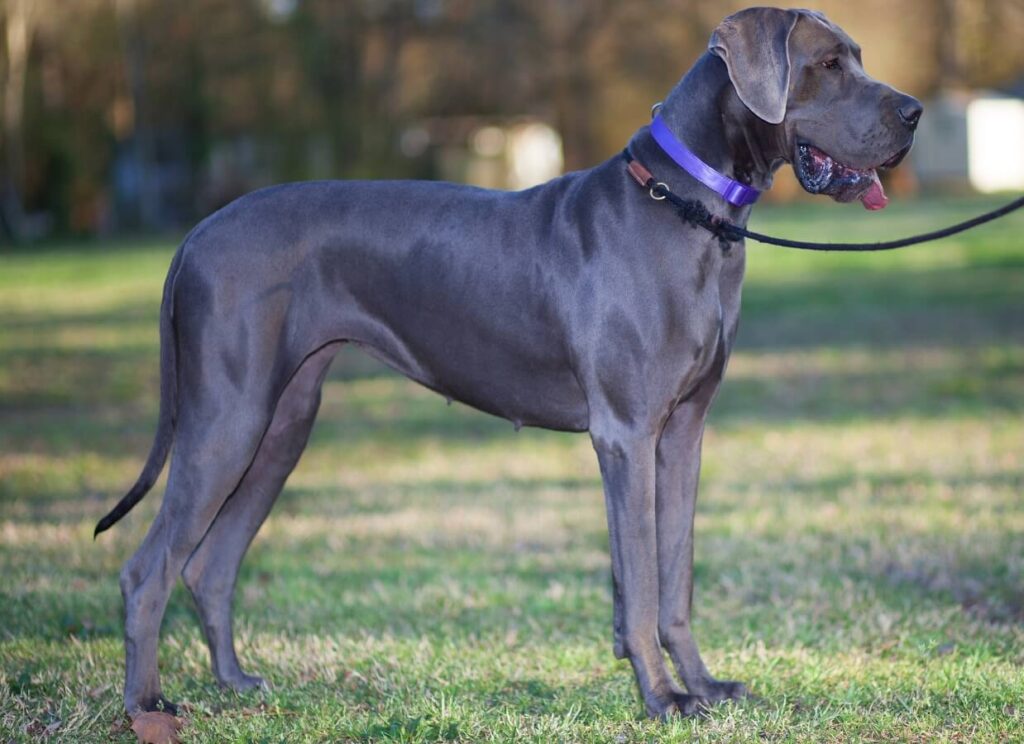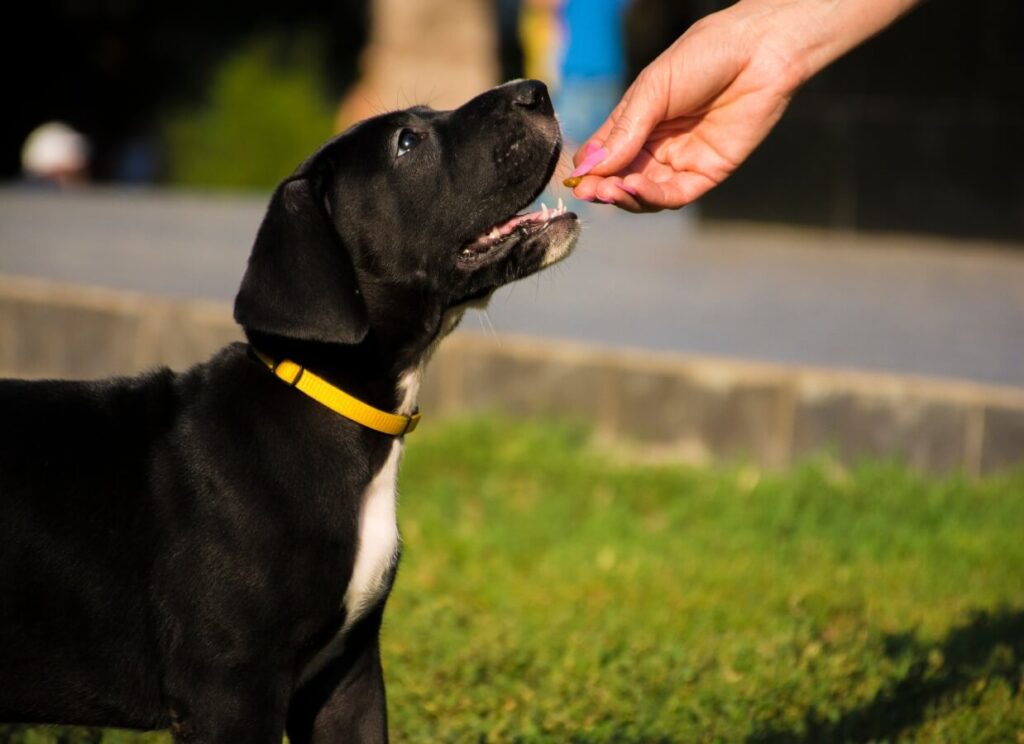Taking a Great Dane for a walk doesn’t have to be a challenging experience filled with pulling and stress. However, many of us have experienced that exact problem! Given their size and tenacity, untrained Great Danes have the tendency to turn the tables. They end up walking us instead. If walking a Great Dane on a leash calmly and gently is something you would like to do properly, this article is for you!
This article covers:
- The dangers of Great Danes with bad leash manners
- How to teach Great Dane puppies to walk on a leash
- Training tips for teaching adult Great Danes to stop pulling
- The best tools and gear for Great Danes

1. Leash Skills Matter for Great Danes
Inappropriate leash skills can actually cause damage to both you and your pets.
It is essential to train your Great Dane the appropriate way to walk on a leash. Not only will this make public times more enjoyable for both of you, but it can also prevent health problems that can occur from pulling on the leash.
Damage to Dogs from Poor Leash Skills
Some common problems that can arise from incorrect leash skills are joint damage, neck and back injuries, and tracheal damage.
These injuries most commonly happen while training dogs when the dogs yank extremely hard. This hard pulling causes the Great Dane’s owners to feel the need to yank back in order to gain control. This tension between owner and dogs can create extreme unnecessary strain on a large breed dog’s neck.
Injury to an Owner’s Back/Neck from Negative Leash Skills
Owners too, can get injuries from large breed dogs who are stronger than them and eager to yank on walks.
If your dog is excited and sees a rabbit or other dog, they can yank so hard that you might be pulled off your feet. This can cause serious injuries to your back or neck.
Additionally, if they are ‘chronic pullers’, your back / spine / neck will get fatigued and your muscles can begin to feel sore or painful.
Training your Great Dane to act correctly in public from the start will save you both a lot of pain and frustration in the long run.

2. Teaching a Great Dane Puppy How to Walk on a Leash
Teaching a Great Dane puppy to walk on a leash involves patience, consistency, and positive reinforcement. Here are some steps you can follow:
- Start Early:
Begin leash training as early as possible, ideally when your Great Dane is still a puppy. This helps them develop positive associations with the leash and prevents the formation of bad habits. - Get the Right Equipment:
We recommend using a wide, flat martingale collar which is escape proof and safe as long as the puppy is not pulling. Read HERE for why we do not recommend front-clip “no-pull” harnesses or Gentle Leader head collars. - Introduce the Leash:
Let your puppy get used to the leash by allowing them to investigate it in a controlled environment. Praise and reward them for any positive interaction with the leash. - Associate Positive Experiences:
Associate the leash with positive experiences. For example, put the leash on before mealtime or playtime. This helps create positive associations with the leash. - Indoor Practice:
Start leash training indoors where there are fewer distractions. Allow your puppy to drag the leash around while supervised, praising them for walking calmly. - Short Walks:
Begin with short walks in a quiet and familiar environment. Keep the walks positive and enjoyable. Use treats and praise to reward your puppy for walking nicely on the leash. - Avoid Pulling:
If your puppy starts pulling, stop walking. Do not move forward until they return to your side. Reward them for walking beside you. - Consistency is Key:
Be consistent with your commands and rewards. Use the same cues and rewards every time you walk. Consistency helps your puppy understand what is expected. - Gradual Exposure:
Gradually expose your puppy to different environments, people, and other dogs while on the leash. This helps them become accustomed to various stimuli. - Positive Reinforcement:
Always use positive reinforcement. Reward good behavior with treats, praise, or play. This encourages your puppy to repeat the desired behavior. - Patience and Calmness:
Stay patient and calm during the training process. Avoid getting frustrated, as puppies can sense your emotions. Training should be a positive and enjoyable experience for both of you.
Remember, every puppy is unique, so adjust your training approach based on your Great Dane’s individual needs and temperament. If you encounter specific challenges, consider seeking guidance from a professional dog trainer.
3. Using a Long Leash with Your Great Dane Puppy
Using a long leash is a valuable tool when training calm leash skills and recall in Great Dane puppies.
The extended length provides them with a sense of freedom while maintaining control. During training sessions, start in a secure and spacious area, allowing the puppy to explore and move around with the extended lead.
PRO TIP: We highly recommend doing this in LOW distraction areas where there is no chance your excited Great Dane puppy will wrap themselves around another dog or human they encounter!
Reinforce positive behavior by rewarding them for walking calmly beside you and responding to recall commands. The length of the leash allows for gradual distance increases, promoting a strong recall response.
As the puppy becomes accustomed to the long leash, it serves as a bridge to off-leash training, fostering a sense of reliability and trust between the owner and the Great Dane. Consistency, positive reinforcement, and gradual progression are key elements in utilizing a long leash effectively for cultivating both leash manners and recall abilities in these large and lovable puppies.
Do not forget to reward your Great Dane Puppy!
As they respond to your commands and learn to stay close, reward your Great Dane puppy with lots of training treats. Your pup will probably look clumsy while beginning to leash train and they might even get tangled up in the long leash. That is okay!
We recommend using your puppies kibble to reinforce and reward these skills. You can also use small amounts of high-value treats such as cheese, Charlee Bear, and Ziwi Peak!
4. How to Choose the Best Leash for a Great Dane Puppy
You might think it is okay to choose any collar, any harness, or any leash for your Great Dane puppy or even adult Great Dane. However, each item should be chosen with care!
5. Using a harness for a Great Dane
We do not recommend the use of a harness. There has been some small studies done that show the use of a harness actually can change the way your Great Dane puppy and adult Great Dane begins to walk and move. The harness can add additional strain on your dane, causing them to pull harder and changing the way that their body allows them to move.
6. Which collar is best for training purposes
You will need to make a decision whether or not you will like to e collar train your Great Dane. We are advocates of ethical, balanced e collar training. You can find an abundance of e collar training resources in our ecollar guide below.
However, never attach a leash onto the e collar. You will need an additional collar to attach your Great Dane onto with a leash. Great Danes and other dogs should never have a leash attached to their e collar.
Standard collars come in all sorts of designs, colors, patterns and fabrics. We recommend prioritizing one that fits correctly, is washable or wipeable and that is suitable for a big dog. Great Dane owners will likely need to purchase multiple collars: one for their puppy, possibly one for a teenager Great Dane, and another for adult Great Danes.
Taking Your Great Dane Puppy on a Walk on a Leash
When leash training a Great Dane puppy, start with your first outdoor walk on a leash in an environment with as few distractions as possible – inside the house or in the backyard are good places to start. This time, you will be using a standard length leash. Choose a space with enough room to move, but not so much space that you cannot conduct safe and effective Great Dane walking skills.
Start with short distances
Great Danes are active dogs who need lots of mental stimulation and play as well as training. However, leash training should be done in short spurts so that your puppy has positive association and learns that when it is time to train they will not get exhausted by being asked to walk.
Grab some treats and get ready to walk!
Choose a spot that you know your Great Dane will be safe and free from distractions. Have your puppy wear the leash for short periods of time at first, gradually increasing the amount of time as they get used to it. Start to walk with your Great Dane for a few steps, then stop your puppy and say their name to get eye contact. Then ask your dane to sit. If their bottom moves downward into a sit position, say the marker word ‘YES’, and reward heavily!
Short, frequent breaks and praise while training to walk
Reward your puppy with treats or praise whenever they walk calmly on a leash or listen to other commands like sit. Great Danes are a growing, large and strong breed so it is of utmost importance to lead them by a confident, calm and peaceful example. They are also extremely intuitive and will pick up on their owners nerves and feelings.
7. Why does eye contact with Great Danes make such a difference?
Also, there can never be too much praise when your Great Dane gives you eye contact. You want to ensure that your Great Dane LOVES to look at you–especially when you are outside and there are so many other fun things to look at. Other dogs, squirrels, people, or noises/smells can take attention of your puppy off of you. But with guidance and training your Dane can learn that you are just as exciting as the distractions.
And be patient – remember that puppies have shorter attention spans than adults, so have shorter training sessions and give lots of patience with your Great Dane puppy!
8. What to do if Your Great Dane Pulls on the Leash
Leash training is a lifelong skill and you might not get the desired behavior right away. Additionally, leash training requires you to continue training throughout the entire life of your Great Dane.
If your Great Dane is pulling on the leash, there are a few things you can do to correct the behavior. First, make sure that your dog is wearing a collar that fits properly. A loose collar can provide too much slack, making it easy for your dog to pull.
Second, keep your walks short at first and gradually increase the distance as your dog gets better at walking on a leash.
Third, be consistent with your commands and rewards. Every time your dog walks calmly beside you, give them a treat or verbal praise.
Next, try to practice in areas with little distractions
Finally, don’t forget to have patience; leash training is a lifelong skill and it will take time for your dog to learn how to walk calmly on a leash.
9. Going from Stressful Leash Walks to Enjoyable Leash walking
When your dog pulls on the leash, you may feel like you’re in for a long walk. However, with a little patience and practice, you can help your dog how to heel and make walks more enjoyable for both of you. To start, stand still for a few seconds after you put the leash on your dog. This will give your pup time to settle down and get used to the leash. Then, begin to walk, very slow, taking only a few steps before stopping again.
Moving into longer distanced walks and Great Dane leash training
Once your dog realizes that he needs to stay by your side, you can start going for longer distances. If at any point during the walk your dog begins to pull ahead, simply stop and wait until he sits back down at your feet. Waiting for your Great Dane to sit is extremely helpful. However, getting that eye contact is of equal importance. Make your eyes super enticing by pulling a treat up to your eye level so that their eyes are lead to your own. This action is training your Great Dane (and other dogs) that by looking to you for guidance they will be rewarded.
Make sure to bring along lots of treats and reward heavily when the pulling resides.
10. The Best Leash for Great Dane Leash Training
The type of leash you use can make a big difference in how successful your training is.
A long leash can be used for more spacious walks once your dog is able to be given more freedom. Long leashes can also be great tools to teach recall. Some long leads are linked below for your convenience.
A short leash is a good choice for more day-to-day practice, as it will give you more control over your dog and prevent them from getting tangled up. The following suggestions can be purchased in 4 feet, 6 feet or 8 feet.
Retractable leashes are not recommended, as they can be difficult to control and may cause your dog to get tangled up.
We recommend being cautious when using a harness or a fancy retractable leash. Most harnesses can cause joint / conformation issues because they put all the pressure on your dog’s chest instead of their back. A standard collar and leash is the best way to go when first starting out with training.
11. How to Teach Leash Manners in the Midst of Distractions
When you’re out with your dog, it’s important to be able to stop them from pulling on the leash or running off after squirrels without losing your cool. Here are a few tips to teach your dog to not pull in the midst of distractions.
First, start with basic obedience commands like sit and stay. Once your dog has mastered these commands in a low-distraction environment, you can begin working on stop walking in areas with more distractions.
If your dog starts to pull or run off after something, simply stop walking. Once they look back at you, start walking again. Direct your Great Dane to give you their attention by showing them that you have treats, and pulling the treats up to your eyes to get good eye contact.
Repeat this process until your dog is responding consistently. With patience and practice, you’ll be able to teach your dog stop leash pulling even in the most distracting situations.
In Conclusion:
In conclusion, with a little patience and practice, you can transform stressful times into enjoyable ones. The key is to be consistent with your commands and rewards, and to keep training sessions short so that your dog doesn’t get overwhelmed. With time and patience, you’ll be able to work with your dog how to heel and have calm, pleasant walks together.




